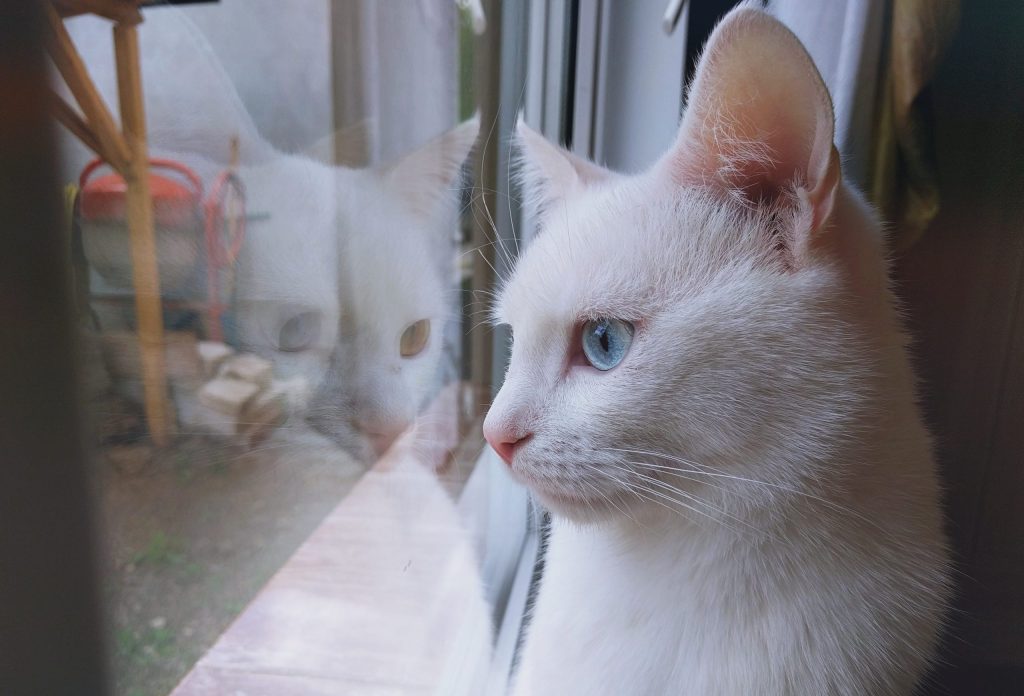
“Falls-from-height” are a common cause of injuries and deaths to Hong Kong’s cat population. Even if your cat goes through a window and doesn’t fall, you’re in for an exciting and stressful time (and possibly a visit from SPCA and some firemen) trying to get the cat back inside again, safely.
Even if you’re not on a high floor, there are other daily dangers to cats: traffic, dogs, snakes, other cats, people…. so window nets are still needed even if you’re living on a low floor (e.g. village house).
At Paws United, we aim to ensure our cats to go to homes where they will be safe, and we know you want your adopted cats to be safe as well, so this guide sets out our expectations concerning window nets.
Window nets must be fitted before an adoption is approved.
Let’s be clear, we aren’t trying to force our adopters into doing things against their will. The cat’s safety is something we should all be concerned about. When people tell us, “I never open the windows”, we have to ask them: “What about your other family members? Your visitors? Your helper? Workmen who come to fix or clean things?” It is very difficult to guarantee that windows will stay closed, and even a brief mistake is enough to endanger a cat’s safety.
Not usually. For most adopters, we just ask you to send pictures or videos of your window nets to us via WhatsApp. We might ask you to zoom in on certain areas, or video yourself giving the net a good shake. Even so, in rare cases we might request a home visit to inspect window nets and the environment.
We look at four things when we consider window nets:
- Coverage: have all the necessary windows been made safe?
- Hardness: is the window net going to bend or flex?
- Fixing: is the window net going to come loose or come off?
- Gaps: can a cat squeeze through the net?
Let’s review these in a bit more detail.
Coverage
Does every window that could open need a net? Not really. Lower windows that people can easily reach always need nets. Higher windows that are out of reach (without steps or a chair) don’t need nets as long as you never open them. We like to see these windows fastened closed with cable ties.
Easy-to-reach windows in every room need a net – including the bathroom, kitchen, and all the bedrooms. It’s perfectly fine to consider some rooms “off limits” to your cat… but cats have a way of sneaking into rooms (especially where they aren’t allowed!), and you have to assume that is going to happen.
Hardness
Window netting must be rigid. Anything based on fabric is unacceptable because it will eventually be torn. Anything flexible or soft, like plastic mesh or metal barbecue mesh, is also a bad idea. Cats can be stronger than you think, and can also be incredibly persistent, so if there is any possibility that they can move the window nets, they’ll probably try to do that – and keep trying until they succeed. We prefer to see a heavy-duty metal grid, like the ones in the following photographs:
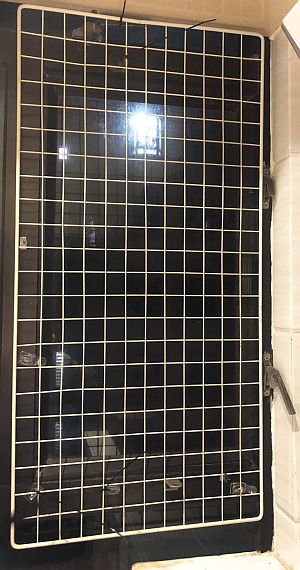
A rigid metal mesh, which is preferred for window nets.
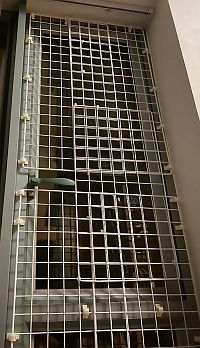
Another example of a rigid metal mesh.
Fixing
The window nets must be firmly held in place in a way that will not become weaker over time. Solutions that we accept – plastic zip-ties, having the nets screwed to the window frame, also purpose-made latches and hinges so your window nets can swing open and closed.
Solutions that we might not accept include wire twist ties (cats love playing with these, and they can become looser over time), any fixings based on adhesive sticky pads (these also become weaker over time), and velcro.
Make sure the window nets are fixed as close to the edges of the net as possible. If the fixing points are too far from the edge, even with rigid nets, cats might be able to push their way through.
It should be possible to grip your window net and give it quite a firm shake. It should not come off, and no gaps should open up. We may even ask for a video of you doing this! Your cat may well also try to test your window nets:
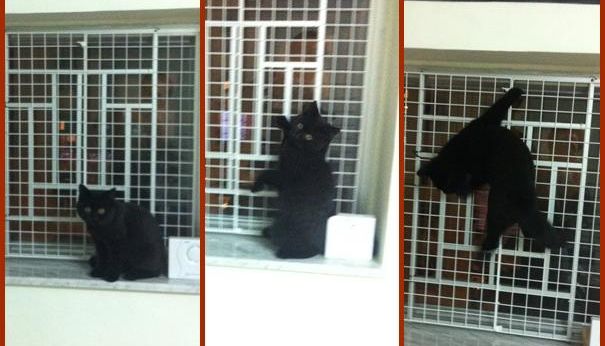
This is one reason why nets need to be firmly fixed in place
Gaps
Kittens especially, but even adult cats, can squeeze through surprisingly small gaps. That means that your window nets should have no gaps at the edges of the window (especially at the top), or where two pieces of netting overlap (At overlaps, the two pieces of netting should be firmly fixed to each other).
Many windows have existing child-proof barriers like this:
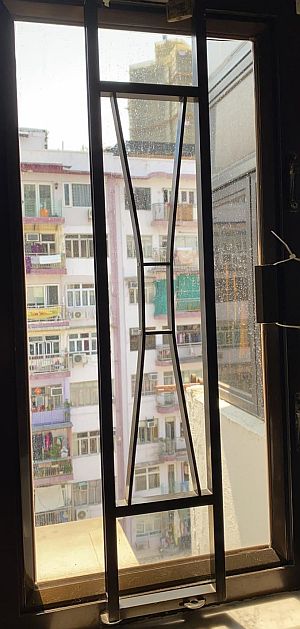
Example of a child-proof barrier – this won’t protect cats, and your window nets may need to be installed behind this barrier to avoid gaps
Sometimes, if the barriers are big or if they stick out a long way from the window, fixing the window nets to the front of these barriers creates a gap around the edges. Your cat-proof window nets might have to be fixed behind the barrier, directly against the window. You can certainly attach the window nets to the child-proof barrier.
We may ask for photos of your nets from different angles, and we may reject the nets if any gaps are too big.
A window that you never intend to open can be permanently fastened shut. This could be done with plastic zip-ties, a window frame lock, or a screw or bolt through the window frame. A window that has been permanently disabled does not need window nets.
Some types of child lock can also be used, like this one:
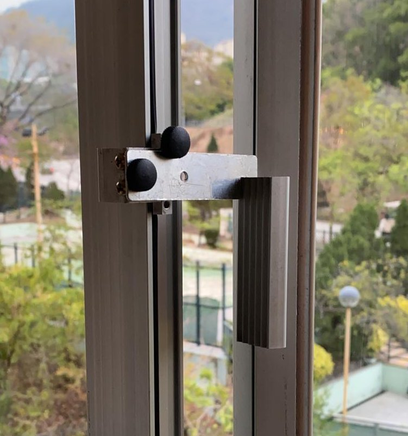
Child-proof lock, firmly attached to window frame and handle, limiting the opening distance to less than 3cm
There are two requirements:
- The lock has to be firmly attached, so that it cannot fall off, or be loosened over time
- It has to be able to secure the window less than three centimetres open. Some child locks leave a gap which is far too small for children, but easily big enough for a cat.
Again, we will require photographs of the child lock. Not all windows are suitable for such locks.
Obviously, cats should never be allowed out onto a balcony. Some cats are cautious about heights, but others can be instantly distracted by a bird or insect flying past, and will jump to catch it without even thinking about how high up they are.
Windows need nets because windows usually stay open for a long time. Balconies – which are mostly used for drying laundry, a quick smoke, or growing some pot plants – might need to be accessed now and then, but there is not usually any reason for the balcony door to be kept open, like you would keep a window open.
That means it’s easier to accept that a careful, caring owner can shut their cat safely in a bedroom before opening – and then closing – the balcony door. Of course, the caring, careful owner must be sure to do this every time the balcony is accessed.
However, if you’re the type who likes to keep the balcony door open, it is possible to have sliding mesh doors fitted. Some of our adopters have done just that, with the help of local engineering firms.
Having a balcony does not rule out adoption, but we will talk about it with you in some detail.
If you have any additional questions, please email us at hello@pawsunited.org.hk
高空墮下是香港貓隻受傷和死亡的常見原因。即使你的貓貓能夠遊走窗邊而不會掉落,依然不能免除你將來為了將貓貓安全帶回屋內,可能面對的過度刺激和壓力(以及需要愛護動物協會及消防員協助的可能性)。
就算你住於低層,外面的世界同樣充滿危機:車輛、狗隻、蛇、其他貓隻、人類等等,可見住於低層如村屋,窗網仍然係必需品。
在PUC,我們的目標是確保貓貓能夠去到安全的新家庭,相信你同樣希望提供給領養的貓貓一個安全的環境,我們準備了以下指引,方便說明我們對窗網的一些基本要求。
批准領養的前提是窗網已經裝好。
必須澄清,我們並非強迫領養者做一些他們不願意做的事,貓貓的安全才是我們都要重視的地方。當大家告訴我們 「我從不會打開窗戶」,我們會想確認 「如果是你的家人呢?你的訪客?你的工人?來修理或者清潔的工人?」這些情況下我們很難保證窗戶能夠一直保持關閉,甚至一個微少的錯誤就有可能危害貓貓的安全。
很少。大多數情況下,我們只會要求領養者以WhatsApp 提供窗網的圖片及短片。我們可能需要你放大某些位置,或者以短片拍攝你搖晃窗網的過程,以確保窗網的穩定性。話雖如此,少數情況下我們可能要求透過家訪去檢查窗網以及整體家居狀況。
當考慮安裝窗網時,通常會考慮以下四個因素:
- 覆蓋度:是否所有必要的窗戶都已經裝有安全措施?
- 硬度:窗網是否會屈曲或者伸縮
- 堅固度:窗網是否不會鬆脫或掉下
- 空隙:貓貓能否從空隙中穿過
讓我們詳細說明每一項。
覆蓋度
是否每個窗戶都需要安裝窗網?非也。人類能夠輕易接觸的較低窗戶需要安裝窗網,而如果需要利用爬梯或者椅子才能接觸的高處窗戶,只要保持關閉,則無須安裝窗網。唯一我們要求高窗以紮線帶綁緊。
所有房間包括浴室,廚房以及所有睡房,裡面的窗戶都需要安裝窗網。我們有時理所當然以為可以將部分房間設為貓貓禁區,但貓貓非常擅長不動聲色潛入房間(尤其當它們被禁止進入該房間時),所以我們有此心理準備。
硬度
窗網一定要足夠堅硬。我們不接受任何以布料做成的窗網,因為它們最終會被抓破;而使用任何柔軟或者有彈性的物料,比如膠網或者燒烤鐵網都未至理想。貓貓比你想像中有力氣,亦比你想像中能夠堅持,如果牠們認為有移除窗網的機會,牠們很大可能會一直繼續嘗試,直到達到目的。因此,最理想是以下參考圖片中的硬金屬網:

以硬金屬網所做的窗網最理想。

另一個硬金屬網的參考例子。
堅固度
窗網一定要安裝牢固,確保不會隨著時間以變弱。我們接受的方案包括膠紮帶,將窗網以螺絲鎖死與窗框上,為了方便窗網開關而特別訂製的窗閂或者鉸鏈。
我們未必接受的方案包括使用鐵線(貓貓喜歡玩鐵線,同時鐵線會逐漸鬆脫)、膠貼(同樣會隨著時間變弱),以及魔術貼的固定方法。
記得確保窗網安裝得越靠近窗邊越好,若然窗網與窗邊留有太多位置,無論多堅固,貓貓都有可能從而穿過。
想有效測試,你可以嘗試大力搖晃裝好的窗網,正常情況窗網應該不會脫落,又或者產生任何罅隙。我們甚至有可能要求你拍搖晃窗網的短片。你的貓貓亦會協助測試安裝好的窗網:

其中一個窗網需要安裝牢固的原因。
空隙
成年貓貓能夠穿過的空隙比我們所想像的細小,,幼貓更甚。所以你的窗網安裝時窗邊(尤其窗網上面位置),或者兩個窗網重疊的位置,都不應留有任何空隙,而窗網重疊處必須堅固扣好。
很多窗戶現時已經裝有以下兒童防護窗花:

以上例子的兒童防護窗花不能保護貓貓,因此你需要在窗花後面安裝窗網,以避免留有空隙。
有時如果窗花太大或者它們與窗戶有一段距離,將窗網裝在窗花前面會在邊緣留有罅隙,因此最好將貓貓防護窗網安裝在窗花後面,貼近窗戶玻璃的位置。當然你亦可將窗網直接裝在窗花上。
我們可能要求你提供窗網不同角度的照片,同時我們有可能拒絕罅隙太大的窗網。
你可以將極少打開的窗戶利用膠紮帶、窗框鎖或者螺絲直接封死,一個封死的窗戶自然無須窗網。
某些種類的兒童防護窗鎖亦不失為好的選擇,例如下面這種:

安裝牢固的兒童防護窗鎖,有效控制開窗範圍不多於3cm。
另外有兩個要求:
- 窗鎖必須安裝牢固,確保不會隨時間脫落或者變鬆。
- 窗鎖必須有效將開窗範圍控制於3cm內。部分窗鎖的開窗範圍雖然對於兒童而言太小,但對貓貓來說已經太大。
同樣的,我們會要求提供兒童防護窗鎖的照片。值得注意,並非所有窗戶都適合安裝兒童防護窗鎖。
顯然易見,貓貓不應被准許走出露台。部分貓貓會對高度有所防範,但有時它們會忽視所處的高度,而跳高捕捉眼前飛過的鳥兒或者昆蟲。
窗戶需要裝上窗網因為它們通常長期開啟。而一般只用作晾衫、吸煙、栽種盆栽而需要出出入入的露台,未必有原因需要好像窗戶保持長期開啟。
換言之,我們可以接受一位小心負責的主人,能夠確保在出入露台之前,貓貓已經被妥善地關在房間內。當然,這位小心負責的主人必須確保每次出入露台都會一樣小心注意。
然而若果你偏向想長期保持露台門開啟,可以參考我們部分領養養者,透過本地工程公司為露台安裝一個滑動網門。
露台不會成為你領養貓貓的障礙,但我們會與你討論當中細節。
如果你有任何其他問題,歡迎email 我們hello@pawsunited.org.hk